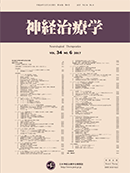Volume 40, Issue 4
Displaying 1-50 of 88 articles from this issue
-
2023Volume 40Issue 4 Pages 413-418
Published: 2023
Released on J-STAGE: November 27, 2023
Download PDF (442K)
-
2023Volume 40Issue 4 Pages 419
Published: 2023
Released on J-STAGE: November 27, 2023
Download PDF (198K)
-
2023Volume 40Issue 4 Pages 420
Published: 2023
Released on J-STAGE: November 27, 2023
Download PDF (180K) -
2023Volume 40Issue 4 Pages 421-424
Published: 2023
Released on J-STAGE: November 27, 2023
Download PDF (607K)
-
2023Volume 40Issue 4 Pages 425
Published: 2023
Released on J-STAGE: November 27, 2023
Download PDF (132K)
-
2023Volume 40Issue 4 Pages 426-431
Published: 2023
Released on J-STAGE: November 27, 2023
Download PDF (1494K) -
2023Volume 40Issue 4 Pages 432-437
Published: 2023
Released on J-STAGE: November 27, 2023
Download PDF (1336K) -
2023Volume 40Issue 4 Pages 438-440
Published: 2023
Released on J-STAGE: November 27, 2023
Download PDF (386K)
-
2023Volume 40Issue 4 Pages 441
Published: 2023
Released on J-STAGE: November 27, 2023
Download PDF (290K) -
2023Volume 40Issue 4 Pages 442-444
Published: 2023
Released on J-STAGE: November 27, 2023
Download PDF (615K) -
2023Volume 40Issue 4 Pages 445
Published: 2023
Released on J-STAGE: November 27, 2023
Download PDF (163K) -
2023Volume 40Issue 4 Pages 446-448
Published: 2023
Released on J-STAGE: November 27, 2023
Download PDF (366K) -
2023Volume 40Issue 4 Pages 449
Published: 2023
Released on J-STAGE: November 27, 2023
Download PDF (185K) -
2023Volume 40Issue 4 Pages 450-453
Published: 2023
Released on J-STAGE: November 27, 2023
Download PDF (1452K)
-
2023Volume 40Issue 4 Pages 454
Published: 2023
Released on J-STAGE: November 27, 2023
Download PDF (269K) -
2023Volume 40Issue 4 Pages 455-457
Published: 2023
Released on J-STAGE: November 27, 2023
Download PDF (538K) -
2023Volume 40Issue 4 Pages 458-462
Published: 2023
Released on J-STAGE: November 27, 2023
Download PDF (578K) -
2023Volume 40Issue 4 Pages 463-466
Published: 2023
Released on J-STAGE: November 27, 2023
Download PDF (1331K) -
2023Volume 40Issue 4 Pages 467
Published: 2023
Released on J-STAGE: November 27, 2023
Download PDF (196K) -
2023Volume 40Issue 4 Pages 468-471
Published: 2023
Released on J-STAGE: November 27, 2023
Download PDF (445K) -
2023Volume 40Issue 4 Pages 472
Published: 2023
Released on J-STAGE: November 27, 2023
Download PDF (181K)
-
2023Volume 40Issue 4 Pages 473
Published: 2023
Released on J-STAGE: November 27, 2023
Download PDF (273K) -
2023Volume 40Issue 4 Pages 474-477
Published: 2023
Released on J-STAGE: November 27, 2023
Download PDF (341K) -
2023Volume 40Issue 4 Pages 478
Published: 2023
Released on J-STAGE: November 27, 2023
Download PDF (186K) -
2023Volume 40Issue 4 Pages 479-483
Published: 2023
Released on J-STAGE: November 27, 2023
Download PDF (419K) -
2023Volume 40Issue 4 Pages 484-487
Published: 2023
Released on J-STAGE: November 27, 2023
Download PDF (375K)
-
2023Volume 40Issue 4 Pages 488
Published: 2023
Released on J-STAGE: November 27, 2023
Download PDF (249K) -
2023Volume 40Issue 4 Pages 489-493
Published: 2023
Released on J-STAGE: November 27, 2023
Download PDF (761K) -
2023Volume 40Issue 4 Pages 494-497
Published: 2023
Released on J-STAGE: November 27, 2023
Download PDF (516K) -
2023Volume 40Issue 4 Pages 498
Published: 2023
Released on J-STAGE: November 27, 2023
Download PDF (190K) -
2023Volume 40Issue 4 Pages 499-502
Published: 2023
Released on J-STAGE: November 27, 2023
Download PDF (474K)
-
2023Volume 40Issue 4 Pages 503
Published: 2023
Released on J-STAGE: November 27, 2023
Download PDF (257K) -
2023Volume 40Issue 4 Pages 504-507
Published: 2023
Released on J-STAGE: November 27, 2023
Download PDF (492K) -
2023Volume 40Issue 4 Pages 508-510
Published: 2023
Released on J-STAGE: November 27, 2023
Download PDF (343K) -
2023Volume 40Issue 4 Pages 511-515
Published: 2023
Released on J-STAGE: November 27, 2023
Download PDF (937K) -
2023Volume 40Issue 4 Pages 516-520
Published: 2023
Released on J-STAGE: November 27, 2023
Download PDF (2045K) -
2023Volume 40Issue 4 Pages 521-525
Published: 2023
Released on J-STAGE: November 27, 2023
Download PDF (1628K)
-
2023Volume 40Issue 4 Pages 526-530
Published: 2023
Released on J-STAGE: November 27, 2023
Download PDF (1137K) -
2023Volume 40Issue 4 Pages 531-536
Published: 2023
Released on J-STAGE: November 27, 2023
Download PDF (1197K) -
2023Volume 40Issue 4 Pages 537
Published: 2023
Released on J-STAGE: November 27, 2023
Download PDF (186K) -
2023Volume 40Issue 4 Pages 538-540
Published: 2023
Released on J-STAGE: November 27, 2023
Download PDF (1185K)
-
2023Volume 40Issue 4 Pages 541
Published: 2023
Released on J-STAGE: November 27, 2023
Download PDF (273K) -
2023Volume 40Issue 4 Pages 542-546
Published: 2023
Released on J-STAGE: November 27, 2023
Download PDF (644K) -
2023Volume 40Issue 4 Pages 547-549
Published: 2023
Released on J-STAGE: November 27, 2023
Download PDF (659K) -
2023Volume 40Issue 4 Pages 550-554
Published: 2023
Released on J-STAGE: November 27, 2023
Download PDF (936K) -
2023Volume 40Issue 4 Pages 555-559
Published: 2023
Released on J-STAGE: November 27, 2023
Download PDF (1140K)
-
2023Volume 40Issue 4 Pages 560
Published: 2023
Released on J-STAGE: November 27, 2023
Download PDF (258K) -
2023Volume 40Issue 4 Pages 561-563
Published: 2023
Released on J-STAGE: November 27, 2023
Download PDF (340K) -
2023Volume 40Issue 4 Pages 564-566
Published: 2023
Released on J-STAGE: November 27, 2023
Download PDF (524K) -
2023Volume 40Issue 4 Pages 567
Published: 2023
Released on J-STAGE: November 27, 2023
Download PDF (179K)
